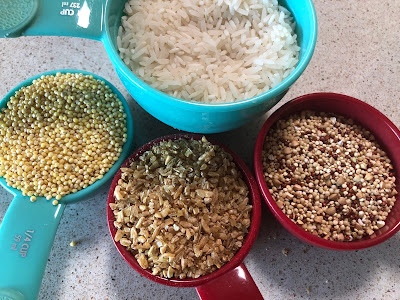
Recipe: Healthy grains are the base for flexible pilaf recipe

Grate tomato halves for the cooking sauce for multigrain pilaf. (Photos: Kathy Morrison)
|

The rich flavor of these Cherokee Carbon tomatoes was perfect
for the pilaf.
|
August is when I start looking for other ways to use my tomato bounty. I've had several BLTs and caprese salads, made cobbler, and I've doused grilled salmon in tomato-basil vinaigrette. I'll get to my usual tomato canning later this month.
In between, I've found a great way to use tomatoes in an easy side dish. This multigrain combo can easily be adapted to whatever flavor profile you want, to accompany tacos, chicken tikka or beef kabobs. A large-hole cheese grater is the only fancy equipment you need, and you don't have to strain out the seeds -- they become part of the texture of the dish.
Note that the grains can be varied, but I would keep basmati or jasmine rice as the main one. The others are up to you and your pantry contents.
Four-Grain and Tomato Pilaf
Adapted from "You Say Tomato" by Joanne Weir
Serves 6

Basmati rice, top, and from left, millet, freekah and quinoa
blend went into my version of this pilaf.
|
Ingredients:
3 medium ripe red tomatoes
1 tablespoon canola or vegetable oil
3/4 cup basmati or jasmine rice
1/4 cup quinoa or quinoa blend
1/4 cup millet or bulgur wheat
1/4 cup freekah or amaranth
1/2 teaspoon or more fresh thyme, plus more for garnish, or 1/2 teaspoon ground cumin
1 or 2 shallots, minced
Optional addition: 4-ounce can chopped chilies, drained
1 cup vegetable or chicken stock
Coarse salt and freshly ground black pepper

|
Instructions:
Cut the tomatoes in half. Cup each tomato half in your hand, cut side out, and, using the large holes of a grater, grate the tomato into a bowl. Discard or compost the skins.
Heat the oil in a large saucepan over medium heat. Add the rice and your selection of other grains (the four together should total 1 1/2 cups), and the thyme or cumin and shallots. Stir until the grains are coated and hot, 1 to 2 minutes.
Increase the heat to high and add the stock, 1 1/2 cups water, the tomato juice and pulp, the chilies if using, 3/4 teaspoon salt, and pepper to taste. Bring to a boil, reduce the heat to low, and simmer, covered, until the grains are tender and the liquid is absorbed, about 25 minutes.
Fluff with a fork. Correct the seasonings. Serve, garnished with more thyme or garnish of your choice.
Comments
0 comments have been posted.Sacramento Digs Gardening to your inbox.
Sites We Like
Garden Checklist for week of April 14
It's still not warm enough to transplant tomatoes directly in the ground, but we’re getting there.
* April is the last chance to plant citrus trees such as dwarf orange, lemon and kumquat. These trees also look good in landscaping and provide fresh fruit in winter.
* Smell orange blossoms? Feed citrus trees with a low dose of balanced fertilizer (such as 10-10-10) during bloom to help set fruit. Keep an eye out for ants.
* Apply slow-release fertilizer to the lawn.
* Thoroughly clean debris from the bottom of outdoor ponds or fountains.
* Spring brings a flush of rapid growth, and that means your garden needs nutrients. Fertilize shrubs and trees with a slow-release fertilizer. Or mulch with a 1-inch layer of compost.
* Azaleas and camellias looking a little yellow? If leaves are turning yellow between the veins, give them a boost with chelated iron.
* Trim dead flowers but not leaves from spring-flowering bulbs such as daffodils and tulips. Those leaves gather energy to create next year's flowers. Also, give the bulbs a fertilizer boost after bloom.
* Pinch chrysanthemums back to 12 inches for fall flowers. Cut old stems to the ground.
* Mulch around plants to conserve moisture and control weeds.
* From seed, plant beans, beets, cantaloupes, carrots, corn, cucumbers, melons, radishes and squash.
* Plant onion sets.
* In the flower garden, plant seeds for asters, cosmos, celosia, marigolds, salvia, sunflowers and zinnias.
* Transplant petunias, zinnias, geraniums and other summer bloomers.
* Plant perennials and dahlia tubers for summer bloom.
* Mid to late April is about the last chance to plant summer bulbs, such as gladiolus and tuberous begonias.
* Transplant lettuce seedlings. Choose varieties that mature quickly such as loose leaf.